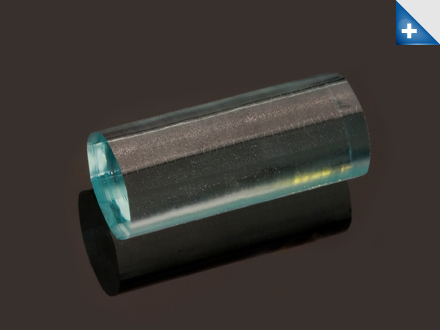
LuAG is of particular interest as a material for diode pumped solid-state lasers employing active ions such as Yb, Tm, Er, and Ho. This host has the smallest lattice constant of the rare earth garnets and the resulting crystal field in LuAG yields narrower linewidths and higher absorption and emission cross-sections. The net effect is higher efficiency laser devices.
Theoretical studies had previously predicted that LuAG should be a superior host for both Tm and Ho lasers.[2] Crystals to support these studies were grown by Scientific Materials under a NASA SBIR program. The experimental results for these materials showed that Tm, Ho, and codoped Tm:Ho LuAG systems were more efficient than comparable YAG and YLF systems.[2],[3] In fact, work has shown that Ho:LuAG has a slope efficiency of 82%, the highest reported.[3] Recent studies of Yb doped LuAG have also shown that it has a higher emission cross-section than YAG.[4] Lasing efficiency was lower, but is believed to be caused by impurities in the LuAG. Research is currently being performed to solve that problem.
In general, LuAG is a robust crystal with physical properties comparable to YAG. However, because Lu is denser than Y, the properties of the crystal do no change appreciably with the addition of dopant ions. For example, the thermal conductivity of 4% Tm:LuAG is about the same as 4% Tm:YAG even though the pure LuAG has a thermal conductivity only 60% that of YAG. The material is harder than YAG, has a higher melting point, and is believe to have a higher damage threshold.
Crystals of LuAG are available doped with Ho, Er, Tm, Tm:Ho, and Yb. Please call us with your specific requirement or for availability and pricing of currently stocked compositions and concentrations.
Contact us with your specific requirements or for availability and pricing.
| Dopant Ion Density @ 1 atomic % | |
| Y3+ Site | 1.42 x 1020 cm-3 |
| Al3+Site (IV) | 1.42 x 1022 cm-3 |
| Al3+Site (VI) | 1.42 x 1022 cm-3 |
| Coefficient of Thermal Expansion [1] | 6.13 x 10-6 K-1 |
| Thermal Diffusivity[1] | 0.030 cm2 s-2 |
| Thermal Conductivity [1] | 8.3 W m-1 K-1 |
| Specific Heat (Cp) [1] | 0.419 J g-1 K-1 |
| Refractive Index @ 632.8 nm | 1.84 |
| dn/dT (Thermal Coefficient of Refractive Index) @ 1064nm [1] | 8.3 x 10-6 K-1 (a) |
| Molecular Weight | 851.81 g mol-1 |
| Melting Point | 1980°C |
| Density | 6.71 g cm-3 |
| MOHS Hardness | 8.4 |
| Crystal Structure | Cubic |
| Standard Orientation | <111> |
| Y3+ Site Symmetry | D2 |
| Lattice Constant | a=11.91 Å/td> |
1) Thermo-optic properties of YAG and other laser host materials are studied in: R. L. Aggarwal, et. al., JOURNAL OF APPLIED PHYSICS 98, 103514 (2005)
2) E. D. Filer, N. P. Barnes, and C. A Morrison, Theoretical Temperature-Dependent Branching Ratios and Laser Thresholds of the 3F4 to 3H6 Levels of Tm3+ in Ten Garnets,
OSA Proceedings on Advanced Solid-State Lasers, 10, 189 (1991); E. D. Filer, C. A Morrison, G. A. Turner, and N. P. Barnes, Theoretical Branching Ratios for the 5I7 ? 5I8
Levels of Ho3+ in the Garnets A3B2C3O12 (A = Y, La, Lu, Gd; B = Al, Lu, Sc, Ga; C = Al, Ga), OSA Proceedings on Advanced Solid-State Lasers, 6, 354 (1990).
3) M. G. Jani, N. P. Barnes, K. E. Murray, and R. L. Hutcheson, Diode Pumped Ho:Tm:Lu3Al5O12 Room Temperature Laser, OSA Proceedings on Advanced Solid-State
Lasers, 20, 109 (1994); N.P. Barnes, M.G. Jani and R.L. Hutcheson, "Diode Pumped Tm:LuAG Laser" Applied Optics 34, 4290 (1995).
4) D. W. Hart, M. Jani, and N. P. Barnes, Room Temperature Lasing of End-Pumped Ho:Lu3Al5O12, Opt. Lett. 21, 728 (1996).
5) D.S. Sumida, T.Y. Fan and R. Hutcheson, Spectroscopy and Diode-Pumped Lasing of Yb-Doped Lu3Al5O12 (Yb:LuAG), OSA Proceedings on Advanced Solid-State Lasers,
24, 348 (1995).